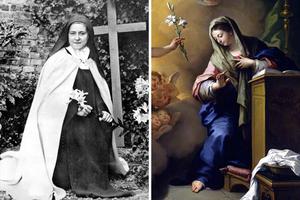‘The Little Way of Living With Less’: St. Thérèse’s Tips for Decreasing Material and Spiritual Clutter
Ultimately, the quest is about learning to let go of material things to make room for the things that matter.

Even before recent obstacles like shortages and a rise in inflation, research has shown that more and more Americans desire to adopt minimalism and declutter.
The Little Way of Living With Less, published by my employer, Sophia Institute Press, offers tips for doing so.
Drawing from her own personal experience of consistently downsizing with intentionality, from McMansion to townhouse, author Laraine Bennett tackles internal and external clutter and shares her proven methods for identifying the “mess” in our lives — guided by the wisdom of St. Thérèse. Each section of Bennett’s book contains a reflection, coupled with the insightful “roses” of the Little Flower, practical tips from a professional organizer and action items.
St. Thérèse understood the value of simplicity and the insignificance of material things at an early age.
The pivotal turning point was her Christmas conversion in 1886. Back then, the French tradition was for children to leave their shoes out by the fireplace for their parents to fill with treats. Upon returning from midnight Mass, 13-year-old Thérèse overheard her unusually cross and tired father saying, “Thérèse ought to have outgrown all this sort of thing, and I hope this will be the last time” (The Story of a Soul). Overhearing what her father had said, Thérèse recounts in her diary that her father’s words “cut me to the quick. … I was not the same Thérèse anymore; Jesus had changed me completely” (The Story of a Soul). She recognized that she needed to forget herself and let go of the material things that heightened her sensitivity in order to become charitable and to please others.
From this point on, she adopted a lifestyle of charity and simplicity — not for the sake of rendering personal happiness but because she knew that the joys of heaven far surpassed the temporary happiness found in material things.
Identify the Clutter
“Clutter is just a visual representation of delayed decisions,” Bennett writes, explaining it is a temporary Band-Aid attempting to cover a greater void that we either forgetfully or intentionally postpone. The void is different for each person: depression, anxiety, loneliness, gluttony, sloth, pride, fear of the unknown, etc. Cultivate the “rose of humility” by naming the void that is your cross of clutter as you read.
Detachment
In her book, Bennett claims that neuroscience has shown that we become anxious when our mind observes clutter because it identifies a problem to be solved. Clutter is often an external representation of our internal state. We need to internally and selflessly detach from our personal cross of clutter before we literally dispose of the waste. This allows us to become more grateful and to fill our void with the things that matter, the virtues.
Purge the Unnecessary
St. Thérèse is famous for her “Little Way”: doing ordinary things with great love. Her method for spiritual sanctification can be applied when discarding material clutter. One helpful strategy: Set a time limit or expiration date. If you haven’t used an item in six months to a year, donate it, recycle it or throw it out. Donate duplicated items and sentimental things that have been forgotten about. Trash broken objects. Although this may be time-consuming, the long-term investment is saving money, space and time, while also giving way to a sense of order, peace and interior freedom.
Ultimately, this quest is about learning to let go of material things to make room for the things that matter. Thérèse assures us that “happiness has nothing to do with the material things that surround us; it dwells in the very depths of the soul” (The Story of a Soul).
Reading this book will help readers better understand the Little Flower and her method for holiness. Bennett’s work is a tribute to the teachings of St. Thérèse and her minimalistic way of life. Her “Little Way” embodies the desired minimalism that many seek because it is grounded in spirituality. Perhaps more Americans would adopt her “Little Way” if they knew of its roots.
- Keywords:
- st. thérèse of lisieux
- book picks

















